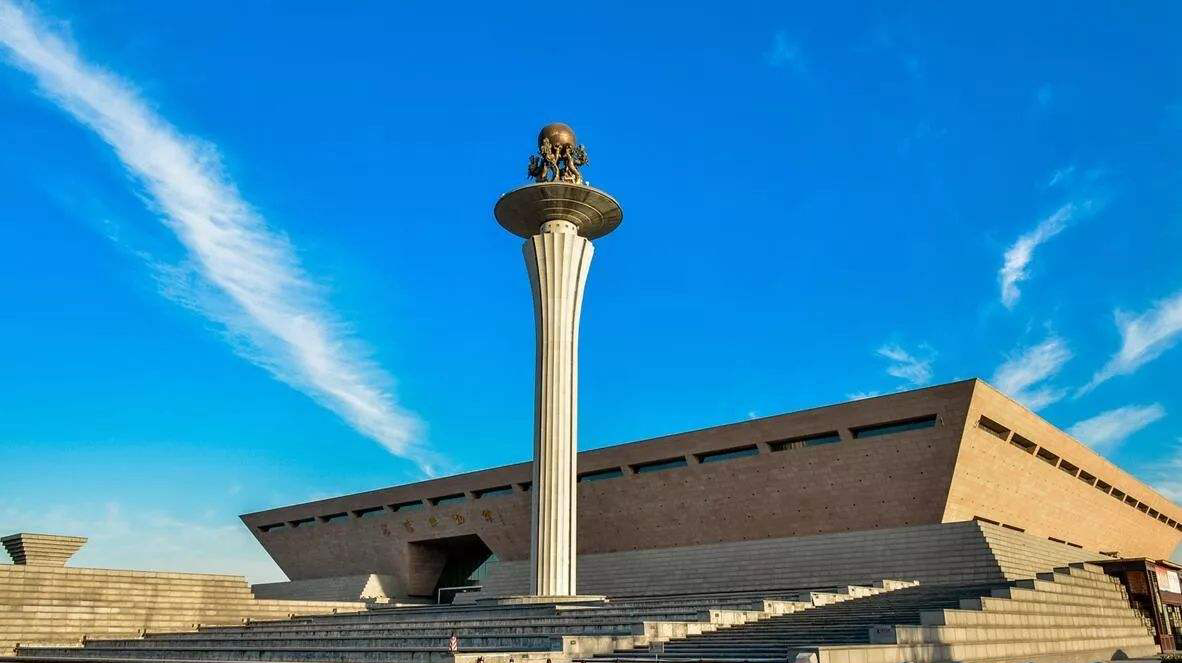Chinese Name: 洛阳博物馆 Pronunciation: luò yang bó wù guǎn
Building Time: 1958
Best Visiting Season: All seasons
Suggested Visiting Hours: 1-2 Hours
Address: Nietai Road, Luolong District, Luoyang City, Henan Province.
Scenic Zone: Covering a total area of 49.42 acres, with a building area of 15.32 acres.
Admission Ticket Fare: Free(Tourists must present valid documents such as an ID card or passport when entering the Luoyang Museum.)
Building Function: Luoyang Museum is a comprehensive museum integrating cultural relics collection, scientific research, display and exhibition, social education and, cultural exchanges.
| Date | Tuesday to Sunday |
| Opening Hours | 9:00-17:00 |
| No Admission | 16:30 |

Founded in 1958, Luoyang Museum is located in Luolong District, Luoyang City, Henan Province. Luoyang Museum has a beautiful environment and convenient transportation, and it is a cultural landmark of Luoyang City.
Luoyang Museum covers an area of 49.42 acres with a building area of 62,000 square meters. It is a comprehensive museum integrating cultural relics collection, scientific research, exhibitions, social education, and cultural exchanges.
Luoyang Museum is the first batch of national first-class museums and a local comprehensive history museum. There are more than 400,000 cultural relics collected in the museum and more than 11,000 cultural relics on display. The number of collections in the Luoyang Museum is at the forefront in the museums of China.

The Luoyang Museum was built in May 1958. During the construction process, it was suspended, expanded, and restored many times. After numerous ups and downs, it finally formed what it is today.
In May 1958, Luoyang Museum was built and its original site was located in Luonan Guanlin, Luoyang. It is one of the earliest museums established at the prefectural level after the founding of the People’s Republic of China.
In the early 1960s, the construction of the museum was affected. During the Great Cultural Revolution, due to internal disputes, the normal construction of the museum came to a halt.
In 1972, the museum took advantage of a simple flower shed in Luoyang Wangcheng Park to hold a cultural relic exhibition. This flower shed became the second temporary site of the Luoyang Museum.
In 1972, the Luoyang City government approved the construction of a new exhibition building for the Luoyang Museum despite financial difficulties.
In 1973, Luoyang Museum moved to Zhongzhou Road in the urban area. The museum exhibition building is a national style building embedded with glazed tiles. And then the museum officially opened on May 1, 1974.
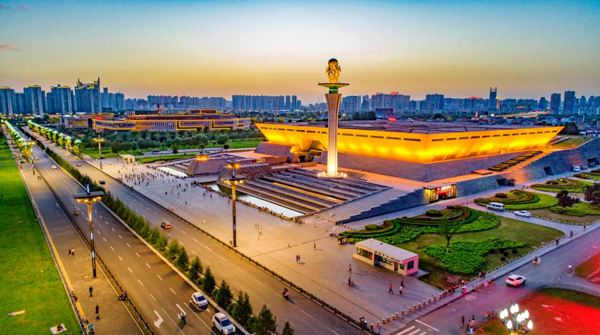
In October 1974, the museum site was completed on Zhongzhou Road in the urban area. It covers an area of 5.77 acres, with an exhibition building area of 2,800 square meters, a cultural relic warehouse of 3,141 square meters, and a comprehensive office building of 1,550 square meters. At that time, there were nearly 400,000 cultural relics in the collection, and about 35,000 cultural relics were available for display.
At the end of 2007, the construction of the new Luoyang Museum started, covering an area of 49.42 acres, with a building area of 62,000 square meters and a total investment of 400 million yuan. The new building is composed of the main building and the annex building. And it was completed in February 2009.
In May 2008, Luoyang Museum was named the first batch of national first-class museums.
In April 2009, the Luoyang Museum held the China 2009 World Philatelic Exhibition.
On April 1, 2011, the new building of the Luoyang Museum opened to the public for testing.
In October 2018, it was rated as the national education base of research and practice for primary and secondary school students.

Luoyang Museum exhibition hall includes seven thematic exhibitions: Heluo Civilization Exhibition, the Treasure Hall, the Han and Tang Dynasty Potteries' Hall, the Tang Tri-colored Glazed Pottery Hall, the Stone Carving Hall, the Calligraphy and Painting Hall, Wangxiu Peony Art Hall, and the Special Local Product Exhibition Halls.
There are about 15,000 permanent exhibits in the Luoyang Museum. The interior is designed with a comprehensive public interaction area and leisure area, as well as a cultural relic collection, research, and restoration area.

Heluo Civilization Exhibition, located on the first floor of the museum, is divided into three small exhibition halls.
In these three exhibition halls, the development of the Heluo civilization can be seen according to the exhibits from different periods. According to the time order, the exhibits are from the prehistoric period, Xia, Shang, and Zhou Periods (BC2070~BC 256), Han-Wei Period (BC202~AD386), the Sui and Tang Dynasties (AD581~AD907), and the Five Dynasties the Northern Song Period (AD907~AD1127).
The exhibition of "Heluo Civilization" was selected as one of the tenth (2011-2012) National Museum Top Ten Exhibitions in 2013.

The Han and Tang Dynasty Potteries' Hall
Located on the second floor of the exhibition hall, the exhibition is chronologically divided into four parts: the Han Dynasty, the Western Jin Dynasty, the Northern Dynasties, the Sui and Tang Dynasties.
Through the exhibition of more than 400 pottery figurines, it shows the basic development of ancient pottery sculpture art. This exhibition hall can be called a vivid pottery sculpture textbook.
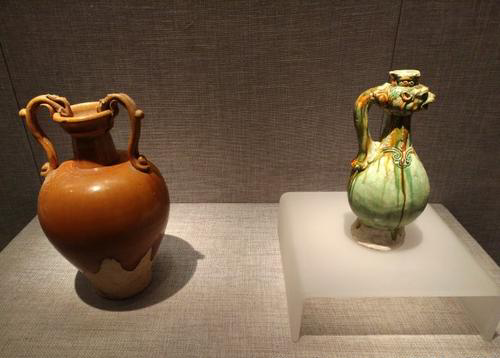
Located on the second floor of the museum, the exhibition introduces the Tang Tri-colored Glazed Pottery by displaying different types of sculptures, including civil servants, heavenly kings, noblewomen, maidservants, horse-riding figurines, tomb beasts, and daily utensils.
The complete line of the sculptures of Tang Tri-colored Glazed Pottery is extremely rare.
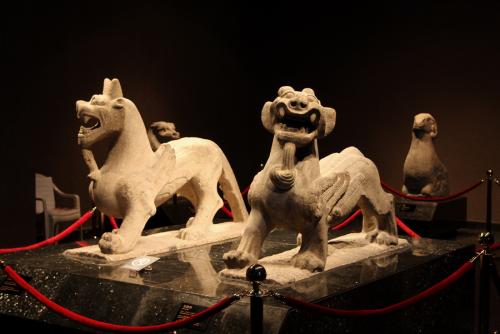
The Stone Carving Hall is located on the first floor of the museum. The exhibition is divided into two parts: stone sculptures and epitaphs.
There are many stone carvings in the Luoyang area from the Han and Tang Dynasties to the Ming and Qing Dynasties. The stone carvings in the museum have strong characteristics of the times and obvious local characteristics. And they occupy an important position in the history of ancient Chinese stone carving art.
The annex buildings on the east and west sides in front of the main entrance of the Luoyang Museum are the Special Local Product Exhibition Halls.
Covering an area of about 3,600 square meters, the exhibition halls mainly gather well-known specialty foods, peony foods, and agricultural and sideline products from Henan Province, especially Luoyang city.

The Calligraphy and Painting Hall is located on the second floor of the museum. There are many exhibits, including literary and artistic works by famous artists such as Su Shi, Kang Youwei, Wu Changshuo, Qi Baishi, and Guo Moruo, and so on.
The literary and artistic works in these exhibitions are mainly from the Qing Dynasty and the modern period.

Wangxiu Peony Art Hall is located on the second floor of the museum.
It exhibits the peony paintings and the blue and white peony porcelain works by Wang Xiu, the honorary curator of Luoyang Museum and chairman of the Luoyang Artists Association.
The Treasure Hall
The Treasure Hall is located on the second floor of the museum. The exhibition selects the most exquisite cultural relics from the past dynasties for a concentrated display, which can be described as the quintessence.
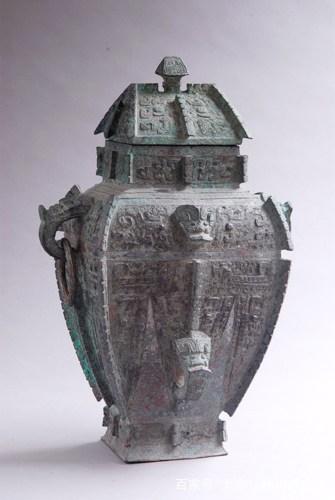
Mu Gu Bronze Rectangular Wine Vessel is a typical type of bronze wine vessel used in the Shang Dynasty, with a height of 50 cm and a width of 33 cm.
Mu Gu Bronze Rectangular Wine Vessel was unearthed in Luoyang North Kiln in 1963. The vessel looks stable and magnificent, and the body of the vessel is decorated with gorgeous patterns. Bronze wine vessels were popular in the late Shang Dynasty. And Mu Gu Bronze Rectangular Wine Vessel is a fine product of the time.
There is an inscription of the "Mu Gu" on the cover of the Mu Gu Bronze Rectangular Wine Vessel. It is regarded as a physical testimony of a woman from the Gu Kingdom marrying a man whose last name is Mu.
This late Shang Dynasty wine vessel was unearthed in the tombs of the nobles of the Western Zhou Dynasty, and it was speculated that it may be the spoils obtained by the nobles of the Western Zhou Dynasty in the War of Destroying Shang Dynasty.
In the autumn of 1947, the Shu Pin Square Yi was unearthed in Xiaoli Village on the outskirts of Luoyang. This artifact is a typical bronze wine vessel or ceremonial vessel in the Western Zhou Dynasty (1046 BC-771 BC), and there is only one of its kind in China, which makes it very precious.
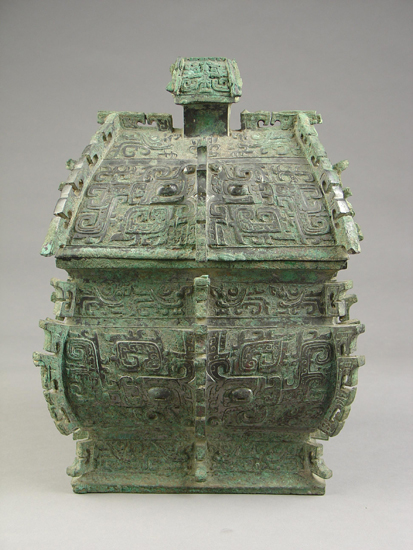
Shu Pin Square Yi is 32.6 cm high, 23.5 cm long, 19 cm wide, and weighs 7.75 kg. It is shaped like an ancient square building and covered with over-elaborate Western Zhou engraving. The exaggerated beast’s face on the side seems oddly threatening.
It is in two parts, the cover and the body. The cover is like the roof of the house with slopes on its four sides. The vertical section of the body is a bulging rectangle. The whole piece looks like a sacrificial temple, making the piece look ancient, dignified, and somewhat mysterious.
The sides of the body are decorated with three layers of engraving. Both the sides and corners have protruding ridges that make the piece appear three-dimensional. The menacing ferocious gulosity designs convey the threat of Western Zhou power even today, adding some mysteries to the whole piece.
Bronzes in this shape like the Shu Pin Square Yi are not often seen in the past archaeological excavation. And we can’t see the vessel’s name in the relevant records. But in a Chinese ancient book called “Erya: Explaining Utensils”, the names of several types of vessels are mentioned, and scholar Guo Pu in Eastern Jin Period explains that these wine vessels categorically are called “Yi”, that is to say, “Yi” is a catchall term for wine pitchers.
Later, in the Song Dynasty, this type of bronze vessel was named “Square Yi” for its shape. It’s technically a wine vessel. But in the past, especially in the Shang and Zhou Periods, these wine vessels were primarily used as ceremonial vessels.
Bronze Square Yi, beyond just serving as wine pitchers, is also an important status symbol for the owner. So, who was the owner of the Shu Pin Square Yi? In the autumn of 1947, an ancient tomb southwest of Xiaoli Village, suburbs of Luoyang, was robbed. Many invaluable relics were found in the tomb. But unfortunately, most of the relics from the bomb were sent abroad. Later studies concluded that this was a late-Shang or early-Zhou tomb. Most of the bronze wares from the tomb contained inscriptions, and in all of them, the characters “Shu Pin” appeared. From that, experts inferred Shu Pin was the man buried in the tomb.
The historical records tell us that the bronze rank system was an important status marker for Western Zhou nobilities. Those buried with five or more bronze vessels were at least equivalent to barons or marquis in the Western Zhou nobility hierarchy. So from that, we can tell that the owner of the tomb was an aristocrat.
In 1960, the Luoyang Cultural Relics Bureau, during a routine survey of their collection, discovered a Western Zhou-era bronze square Yi. This caught the attention of many local experts. From the square Yi’s appearance and the inscription on its interior wall, they determined that this was one of the bronzes stolen from the tomb of the Western Zhou Dynasty. So they named it the Shu Pin Square Yi.
Built in the Northern Wei Dynasty, this Clay Buddha Face was originally a Buddha statue, and was damaged later. The remained part of the statue is the lower face part, which is 25 cm high. Today, we can only see the lower eyelid, nose, mouth, chin, cheek of the face. As presumed by experts, the overall head of the statue should be 45 to 50 cm. If erected, the body may be 3 meters high.
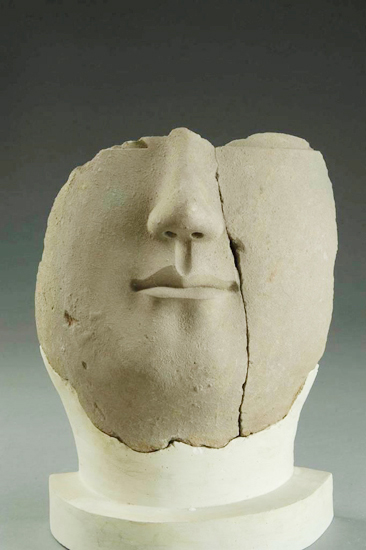
It was unearthed in the foundation ruin of Yongning Temple, a royal temple of the Northern Wei Dynasty, in Luoyang city in 1980. The landmark nine-floored Yongning Pagoda used to be in the center of the temple, and the Clay Buddha Face along with many other relics was stored in this pagoda. According to records, this tower was about 136.7 meters in height. But unfortunately, in the third year of Yongxi Reign (Emperor Xiaowu), which is 534 AD, the pagoda was destroyed by a fire caused by lightning. The fire lasted for three months, and the pagoda was completely down.
The Buddha statues originally enshrined in the wooden pagoda of Yongning Temple were also destroyed with the destruction of the pagoda. Since the founding of New China, archaeologists have conducted scientific archaeological excavations at the remaining Yongning Temple pagoda site, and during the excavations, a large number of beautifully shaped statues have been unearthed, providing valuable physical data for the study of ancient aesthetics and the history of Buddhist statuary.
This Clay Buddha Face was originally a complete Buddha statue, but after the fire, the statue is only left with the parts we can see today and lost all the original painting as well. But these did not affect her beauty in any way. When you see this wonderful statue of Buddha, you will feel joyful and peaceful. Because the smile on the face is so contagious. Though the lips are tightly closed, the corners of the mouth are slightly raised. It looks gentle, in a very profound and impressive way, it feels as if you can feel its unlimited Buddhist power.
In 500 AD, Emperor Xuanwu of the Northern Wei Dynasty succeeded to the throne. He was a big fan of the Buddhist culture. There was once that he met a talented woman called Hu Chonghua (later became Empress Dowager Hu). Hu was well educated in her early childhood and later chose to be a nun at a temple. There she studied Buddhism and became an expert on it.
When Emperor Xuanwu ascended the throne, she was summoned to give a lecture on Buddhism in the royal court. Her charming, graceful, pure, and clever character deeply moved Emperor Xuanwu and she was later made the concubine of the emperor.
Emperor Xuanwu died in 515 AD, the son of Hu then succeeded to the throne, as Emperor Xiaoming. Her son was only 6 years old at the time, so she had to reign behind the curtain as the Empress Dowager (Women cannot rule as the man on the court in ancient times, so she had to hide behind a curtain).
As someone so devoted to Buddhism as Hu, she began to build temples and grottoes on large scale and at huge expenses after seizing the power. During her reign, the number of temples in the country grew to more than 30,000, and with over 2 million monks and nuns. Buddhist temples reached their summit in terms of prosperity since Buddhism was introduced to this land.
It was recorded that there were about 1,300 temples just within Luoyang city during the Northern Wei Dynasty. The most magnificent among them was the Yongning Temple. It took only about one year to build the temple, yet it was magnificent, and the signature building in the temple, the Yongning Pagoda was more than twice the height of the existing tallest pagoda in China, Yingxian Wooden Pagoda in Shanxi province.
Legend has it that after the completion of the Yongning Pagoda, Empress Dowager took her son, Emperor Xiaoming, to ascend the pagoda and overlooked the whole Luoyang city. After that, no one else was allowed to ascend the pagoda anymore and it became exclusive for the royal family. Thus, the pagoda was shut.
It is said that there was a giant luminous pearl at the summit of the pagoda. Each night, the glow of the pearl can be seen by everyone in Luoyang city. This tower became the landmark of Luoyang city then.
Later, in the third year of Yongxi's reign (Emperor Xiaowu), 534 AD, something unexpected happened. With rumbling thunders, the Yongning Pagoda was struck by lightning, and the lightning caused a fire. In face of the sudden fire, Emperor Xiaowu sent 1000 soldiers to put out the fire. But the fire was violent, their effort failed, and the fire had lasted for as long as 3 months. The once towering Buddhist pagoda ended in ash.
The Buddhist statues enshrined in the pagoda were also destroyed together with the pagoda. After the founding of the new China in 1949, excavation on the ruins of Yongning Temple was conducted. During the excavation, lots of delicate statue pieces were unearthed. Among those pieces, the Clay Buddha Face was the most beautiful one. The once complete Buddha statue was now only left with the segment we see today. And its original painting was gone with the fire as well.
According to the experts, it is very likely that the fire burned the Clay Buddha Face into ceramic, then made it harder and corrosion-resilient. It seems that just because of this fire, the Buddha experienced its nirvana.
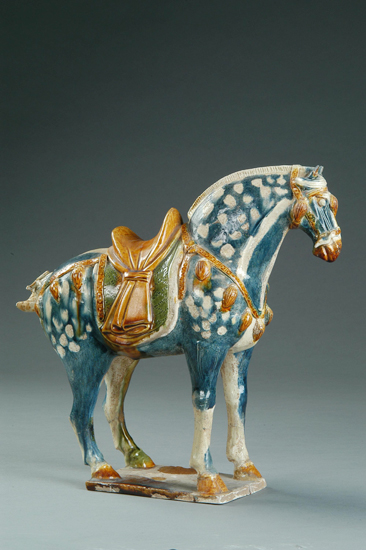
This Tri-Color Glazed Horse is unearthed in Guanlin town of Luoyang in 1981. It is 66.5 cm in height and 84 cm in length. Its body is black, its face, mane, tail and four hooves are white, and the saddle is a mixture of green, yellow, and white. Its color is rare in the tri-color glazed potteries in the Tang Dynasty.
The horse figures in the Tang Dynasty are different from the smooth and clumsy style in the Qin and Han Dynasties and are known for their vivid and elegant posture.
Despite the various postures of the tri-color horse figures, all of them are with the same characters like a small head, round hip, well-proportioned and strong body. It is a reflection of the horses at that time.
In April of 1981, Longmen Brewery in Luoyang decided to build a new factory, and the site was chosen at Guanlin town. At the construction site, a rather large tomb was discovered. It’s the tomb of An Pu and his wife’s, and it’s where the Tri-Colour Glazed Horse was found.
An Pu is a general in the Tang Dynasty. In the Tang Dynasty, there was a small kingdom called Anxi. Anxi was a relatively weak kingdom at the time. It was subordinate to the Turks and had to pay tribute to them every year. In 630 AD, the Emperor of the Tang Dynasty started a war with the Turks, and Xili, the ruler of the Anxi kingdom, took advantage of the Chaos and led his troops to the Tang Dynasty. The Tang Dynasty gave him the title “General Dingyuan”. After the death of Xili, his son An Pu inherited this title and became the new “General Dingyuan”.
In 664 AD, An Pu died in war and was buried in Chang’an (now Xi’an). In 704 AD, his wife He died of illness in Luoyang. To honor his parents, the son of An Pu, An Jinzang, moved An’s bones to Luoyang to be buried with his mother. The tomb mentioned at the beginning of this story was then built. An Jinzang carefully selected a large number of burial objects such as a wide variety of tri-color glazed potteries, and uniquely shaped Eastern Roman gold coins. The Tri-Colour Glazed Horse is one of the rare representative works discovered in this tomb.
Luoyang Museum has a large collection of precious cultural relics from the prehistoric times of the Shang Dynasty to the Ming and Qing dynasties unearthed in the Luoyang area, especially the bronze ceremonial wares of the Xia, Shang, and Zhou Dynasties, the pottery figurines of the Han and Tang Dynasties, the tri-color porcelain of the Tang Dynasty and the porcelain of the Song Dynasty. Rich in variety and regional characteristics, it occupies a certain position in the Chinese cultural relic world.
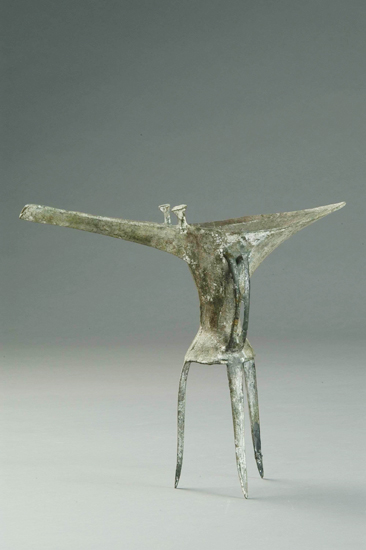
The Nail Pattern Bronze Jue is a type of ceremonial drinking vessel unearthed in 1975 at the Eerlitou Site in Yanshi, Henan Province. It is with a height of 22.5 cm, and a width of 31.5 cm. There is a row of protruding dots as decoration in the middle of this vessel, and the dots pattern looks much like the nails, hence the name Nail Pattern Bronze Jue. This piece is known as the “No. 1 Jue in China” because it is the earliest bronze drinking vessel we have found so far.
Jue is defined as a collective name for ceremonial drinking vessels according to the noted Chinese book “Origin of Chinese Characters”. It explains that Jue is shaped like a bird, and it holds aromatic wine for sacrificial use. The aroma of the wine is for honoring the gods, and pouring the wine on the ground stands for praying for the advent of gods.
Jues are often seen in Chinese costume dramas as drinking vessels, though being a drinking vessel might not have been its original purpose. Because most of the bronze vessels we see today were named by the people in the Song Dynasty, and many conventions were just followed till now.
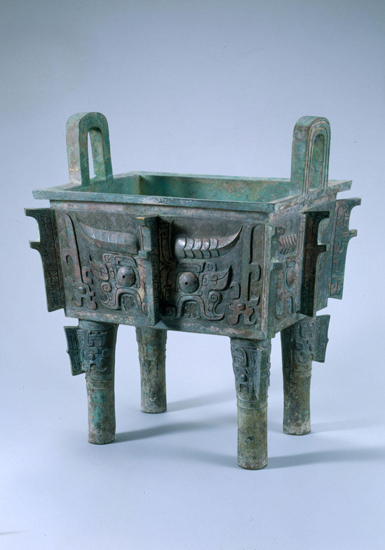
The Bronze Square Tripod with Beast Face Pattern appeared in the Western Zhou Dynasty (1046 BC-771 BC). Its height is 36 cm; the length of its caliber is 33 cm; the width of its caliber is 25 cm. In 1977, it was unearthed in the tombs of the Western Zhou Dynasty in the North Kiln, Pangjiagou, Luoyang City.
The Bronze Square Tripod Vessel with Beast-face Vein has double erected handles. It is a rare and superior work in the early Western Zhou Dynasty. The Bronze Square Tripod Vessel with Beast-face Vein was known as the third largest square tripod vessel in the Western Zhou Dynasty. And it is made of fine workmanship and beautiful in shape. It is a representative work of bronze ritual vessels of the Shang and Zhou Dynasties and has a typical significance.

The Gold and Silver Inlay Spouted Bronze Tripod appeared in the Warring States Period (475 BC-221 BC) and was unearthed underground in the West Industrial Zone of Luoyang City in 1979, with a height of 16.5 cm and a belly width of 13.2 cm. It is in a shape of an oblate sphere and much smaller than the ordinary bronze tripods. This piece is just about the size of an adult’s palm. An upturned short pillar tube, called “Liu (a spout)”, is embedded on its belly. What contains inside the tripod can be poured out through this spout. The surface of the tripod is filled with fascinating gold and silver inlay patterns, inlaid by gold and silver.
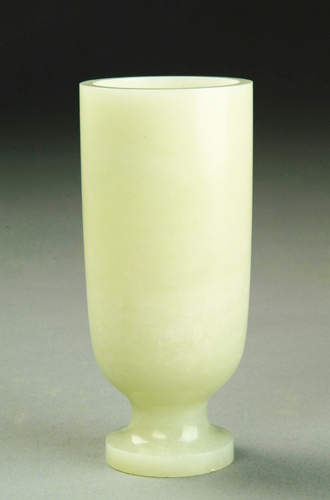
The White Jade Cup appeared in the Wei Dynasty (220-265 AD), and was unearthed in a tomb in Jianxi District, Luoyang in 1956. It is a drinking vessel from the Wei Dynasty. With a height of 11.5 cm, its body is cylindrical and about the size of the wine glasses, we use now. Though without any special design, the carving is very delicate. The cup’s edge, cylindrical body, and corner of the foot are all mellow but distinct. According to experts, this cup is made by first-class white Hetian jade in Xinjiang Province. Thousands of years have passed and you cannot find a single flaw on this White Jade Cup, it is truly a rare treasure.
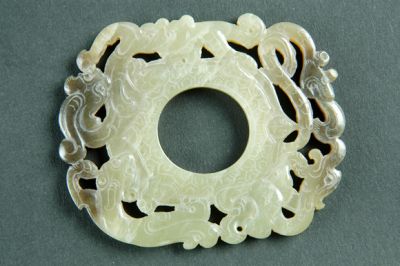
Turquoise Dragon-shaped Artifact appeared in the late Erlitou culture (approximately 21st century BC-16th century BC). In the spring of 2002, it was unearthed in the southern courtyard of the palace at Erlitou site in Yanshi, Luoyang.
The Turquoise Dragon-shaped Artifact is about 65 cm long and is made of more than 2,000 small turquoise pieces of different shapes. Among them, the smallest turquoise piece is only 0.2 cm in diameter and about 0.1 cm thick. The dragon body of the dragon-shaped artifact is slightly curved. The Turquoise Dragon-shaped Artifact is like a wandering dragon. It is exceedingly rare among dragon-shaped artifacts in the early time. It is a well-deserved "sensational treasure" and was named "Chinese Dragon" by experts in China.

Jade Ge appeared in the Shang Dynasty. Unearthed in 1985 in Xizhaizi Village, Luoning County, Luoyang City, Jude Ge is 48 cm long and has an oblique triangle front. It is mainly popular in the Shang and Zhou dynasties. Although its shape resembles a dagger, it is actually a type of ritual vessel.

The Warring States Jade Figure is made with gray jade. It is only 7.50 cm in height. This piece appeared in the Warring States Period (475 BC-221 BC). It was unearthed in Luoyang Copper Processing Factory in 1987.
The Warring States Jade Figure sits in a crouched position, with his hands folded in front of his abdomen, his feet crossed under his hips. He wears a mask, the mask is tied to the back of the head with a rope, and a hair bun is attached to the mask. The Warring States Jade Figure has thick eyebrows, big eyes, high cheekbones, a big mouth, and beards. He wears short-sleeved tops and shorts.
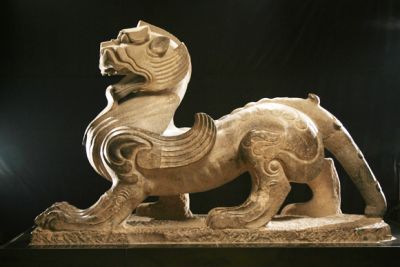
This Bixie of the Eastern Han Dynasty was unearthed nearby the mausoleum of Emperor Guangwu of the Han Dynasty in Youfang Town, Mengjin County in 1992. It is 1.9 meters high, 2.97 meters long, and weighs 8 tons. It is carved with a complete bluestone. Its head looks like that of a lion, with glaring eyes and vertical eyebrows. Its mouth is widely open, and its head slightly leans to the left. Its body is like that of a leopard. And there’s a small beast in its left forepaw.
The Bixie was usually placed on the passages of ancient high-grade tombs for repelling ghosts and evil spirits. It was also believed that Bixie can protect the soul of the dead from being invaded and harassed.
So far, among the unearthed cultural relics in China, this is the only stone inscription with such a large body and exquisite artistic technique.

Stone Inscription of Zhengshi appeared in the Wei Dynasty. It was excavated in Taixue Village, Dianzhuang Town, Yanshi City in 1922. Stone Inscription of Zhengshi is 75.4 centimeters long and 50 centimeters wide.
Tri-Color Glazed Lantern appeared in the Tang Dynasty (68 AD-907 AD), with a height of 45.5cm and a base diameter of 22.6cm. It was unearthed in Jili District, Luoyang in 1987, and was used as a lighting appliance in the Tang Dynasty.

Composed of four parts: a base, a handle, a plate, and a vessel, the Tri-Colour Glazed Lantern is beautiful in shape and bright in the glaze. It is an extremely rare art treasure among the tri-color archaeological discoveries in Luoyang.
Tri-Color Sitting Female Figurine appeared in the Tang Dynasty, with a height of 27 cm. It was unearthed in the North Kiln of Luoyang in 1964. The figurine wears a long yellow skirt, she is plump and graceful, which represents a style of women in the heyday of the Tang Dynasty.
Before visiting the museum, an appointment needs to be made through the Luoyang Museum WeChat official account. Once the appointment is made, you can enter the museum with the voucher you got from the WeChat official account and your ID card.
There’s no museum guide in person in the museum, so visitors can follow the WeChat audio guide from the Luoyang Museum WeChat official account or rent an electronic commentator at the information desk on the first floor of the exhibition hall.
In December 2019, Luoyang Museum won the title of Henan Provincial Museum Excellent Exhibition Work Award, Henan Provincial Museum Social Education Work Advanced Group, and Henan Provincial Museum Advanced Group.
On February 23, 2021, Luoyang Museum was awarded the title of the sixth group of national demonstration sites for learning from Lei Feng (A Chinese role model for being selfless and work for the greater good.).
As a historical and cultural popularization and dissemination institution, the Luoyang Museum attaches great importance to the cultivation of the overall quality of the staff, the building of the talent team, and the results of academic research. The construction and management of books and reference materials in Luoyang Museum are highly valued.
In 1960, due to financial difficulties, Luoyang Museum gave priority to purchasing more than 2,000 copies of historical books such as Four Essential Classics, Si Bu Cong, Twenty-Four History, and academic journals such as Archaeology and Cultural Relics. So, a small reference room was initially formed.
By 1981, the number of books, reference materials and academic periodicals had reached more than 30,000, making it a small library. The library of Luoyang Museum has been relatively complete in the aspect of professional books, which provides the conditions for professional study, data review and academic research.
Jiang Ruoshi, one of the early founders of the Luoyang Museum, is a cultural expert. In 1959, Science Press published an important archaeological report "Luoyang Shaogou Han Tombs" edited by him, which became the basic reference material for guiding the study of tombs in the Northern Han Dynasty.
In 1971, He Guanbao, Chen Chang'an, Cai Yunzhang, and Zhang Jian completed the first draft of a report "Western Zhou Dynasty Tombs from North Kiln in Luoyang". In April 1999, Zhang Jian and other experts presided over the revision and published it by the Cultural Relics Publishing House, which became an important research result of Western Zhou Dynasty archaeology.
In addition, hundreds of papers on archaeological excavation reports, ancient capital history research, museology research, and cultural relic research have been published. Large-scale catalogs in coordination with exhibitions such as Luoyang Tang Tri-Color Glazed Pottery, Cultural Relics Essence, Ancient Capital Luoyang, and Bronze Mirror Unearthed in Luoyang were published.
By Bus
a. From Longmen Railway Station to Luoyang Museum
Take bus 1, or 77, and get off at the Luoyang Bowuguan Station (Luoyang Museum).
b. From Luoyang Railway Station to Luoyang Museum
Take bus 201, 77, 1, or d1, and get off at the Luoyang Bowuguan Station (Luoyang Museum).
By Taxi
Since the Luoyang Museum is located in the urban area of Luoyang, it is more convenient to take a taxi.
Chinese: 请带我去洛阳博物馆。English: Please take me to the Luoyang Museum.
If you go to Luoyang Museum from Luoyang Beijiao Airport, it takes about 30 minutes (about 40 yuan).
If you go to Luoyang Museum from Luoyang Railway Station, it takes about an hour and 17 minutes (about 15 yuan).
If you go to Luoyang Museum from Longmen Railway Station, it takes about 20 minutes (about 20 yuan).
